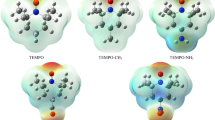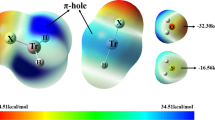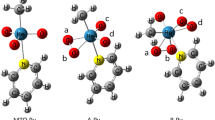Abstract
Herein, we report a quantum chemistry investigation of the interaction between µ-truxinic acid, referred to as TXA0, and Y+ (Y = Li, Na, K) and Z− (Z = F, Cl, Br) ions using M06-2X, B3LYP and \(\omega\) B97XD functionals in conjunction with the 6–31 + + G(d,p), aug-cc-pVDZ(-X2C) and 6–311 + + G (d, p) basis sets. Our computations suggest that Y+ cations can bind to TXA0 through several combinations of cation…O and cation-π interactions, while Z− anions generally establish anion…H–O contacts. Predicted binding energies at the M06-2X/6–311 + + G(d,p) level range between − 26.6 and − 70.2 kcal/mol for cationic complexes and − 20.4 and − 62.3 kcal/mol for anionic ones. As such, TXA0 appears as an amphoteric molecule with a slight preference for electrophilic (cation... O) attacks. Furthermore, the most favourable binding site for cations allows for the formation of O…cation…O interactions where the cation is trapped between O37 and O38 atoms of TXA0. Anions do not behave uniformly towards TXA0: while the fluoride anion F− induces the deprotonation of TXA0, Br− and Cl− do not. All of these structural insights are supported by topological calculations in the context of the quantum theory of atoms in molecules (QTAIM). Finally, SAPT0 analyses suggest that TXA0…Y+ and TXA0…Z− complexes are mainly stabilized by electrostatic and inductive effects, whose combined contributions account for more than 60 percent of the total interaction energy.









Similar content being viewed by others
Data availability
All the datasets supporting the findings reported in this study are included in the manuscript and the supplementary material.
References
Lurie IS, Moore JM, Kram TC, Cooper DA (1990) Isolation, identification and separation of isomeric truxillines in illicit cocaine. J Chromatogr A 504:391–401
Hesse O (1892) Zur kenntniss der cocabl¨atter. Justus Liebigs Ann Chem 271(2):180–228
Liebermann C, Bergami O (1889) Ueber die einwirkung der schwefels¨aure auf γ-und δ-isatropas¨aure. Ber Dtsch Chem Ges 22(1):782–786
Mallette JR, Casale JF (2014) Rapid determination of the isomeric truxillines in illicit cocaine via capillary gas chromatography/flame ionization detection and their use and implication in the determination of cocaine origin and trafficking routes. J Chromatogr A 1364:234–240
Baugh L, Liu R (1991) Sample differentiation: cocaine example. Forens Sci Rev 3:101
Ford CW, Hartley RD (1989) GC/MS characterisation of cyclodimers from p-coumaric and ferulic acids by photodimerisation—a possible factor influencing cell wall biodegradability. J Sci Food Agric 46(3):301–310
Nishikubo T, Takahashi E, Miyaji T, Iizawa T (1985) Convenient synthesis of β-truxinic acid via photodimerization of para-nitrophenyl cinnamate in the crystalline state. Bull Chem Soc Jpn 58(11):3399–3400
Hartley RD, Morrison WH III, Balza F, Towers GN (1990) Substituted truxillic and truxinic acids in cell walls of cynodon dactylon. Phytochemistry 29(12):3699–3703
Yuan X et al (2021) The isolation, structure and fragmentation characteristics of natural truxillic and truxinic acid derivatives in abrus mollis leaves. Phytochemistry 181:112572
Iman A et al (2005) Polymorphism of cinnamic and a-truxillic acids. Cryst Growth Design 5:2210–2217
Cohen M, Schmidt G, Sonntag F (1964) Topochemistry. part ii. the photochemistry of trans-cinnamic acids. J Chem Soc (Resumed) 384:2000–2013
Chi Y-M et al (2006) Anti-inflammatory activity of 4, 4-dihydroxy-α-truxillic acid. Biol Pharm Bull 29(3):489–493
Steri R et al (2010) Truxillic acid derivatives act as peroxisome proliferator-activated receptor γ activators. Bioorg Med Chem Lett 20(9):2920–2923
Krauze-Baranowska M (2002) Truxillic and truxinic acids-occurrence in plant kingdom. Acta Pol Pharm 59(5):403–410
Ahman A, Nissinen M (2006) Pyrogallarenes as alkali metal receptors: the role of cation–π interactions in complexation. Chem Commun (11):1209–1211
Lecomte S, Chenon M-T (1996) NMR investigation of pefioxacin/cation/DNA interactions. Mg2+ and Ca2+ binding. Int J Pharmaceut 139(1–2):105–112
Strugatsky D et al (2005) Genetic polymorphism and expression of a highly potent scorpion depressant toxin enable refinement of the effects on insect na channels and illuminate the key role of ASN-58. Biochemistry 44(25):9179–9187
Garau Rossell´O C et al (2018) s-Tetrazine as a new binding unit in molecular recognition of anions. Chem Phys Lett 2003 vol. 370:7–13
Muya JT, Isamura BK, Patouossa I, Nguyen MT (2020) Interplay between σ holes, anion…H-C, and cation- π interactions in dibromo[2, 2]paracyclophane complexes. J Phys Chem A 124(22):4379–4389
Kolakkandy S, Pratihar S, Aquino AJ, Wang H, Hase WL (2014) Properties of complexes formed by Na+, Mg2+, and Fe2+ binding with benzene molecules. J Phys Chem A 118(40):9500–9511
Petelski AN, Fonseca Guerra C (2019) Hydrogen-bonded rosettes of aminotriazines for selective-ion recognition. The J Phys Chem C 124(5):3352–3363
Fujita S (1994) Unit subduced cycle indices for combinatorial enumeration. Journal of Graph Theory 18(4):349–371
Politzer P, Murray JS (2015) Quantitative analyses of molecular surface electrostatic potentials in relation to hydrogen bonding and co-crystallization. Cryst Growth Des 15(8):3767–3774
Lee C, Yang W, Parr RG (1988) Local softness and chemical reactivity in the molecules CO, SCN and H2CO. J Mol Struct (Thoechem) 163:305–313
Bader R, Nguyen-Dang T (1981) Advances in quantum chemistry. P.-OL¨owdin, Ed. (Academic, New York, 1981) 14:63
Szalewicz K (2012) Symmetry-adapted perturbation theory of intermolecular forces. Wiley interdisciplinary reviews: computational molecular science 2(2):254–272
Shao Y, Wu J, Jiang Y (1996) Enumeration and symmetry of substitution isomers. J Phys Chem 100(37):15064–15067
Rosenfeld VR, Klein DJ, Oliva JM (2012) Enumeration of polycarborane isomers: especially dicarboranes. J Math Chem 50(7)
Baraldi I, Vanossi D (2000) Regarding enumeration of molecular isomers. J Chem Inf Comput Sci 40(2):386–398
Diallo BN, Glenister M, Musyoka TM, Lobb K, Bishop OT (2021) SANCDB: an update on South African natural compounds and their readily available analogs. J Cheminform 13(1):1–14
Nemba RM, Issofa P, Edamak A (2012) Combinatorial enumeration and symmetry characterization of homodisubtituted [2, 2] paracyclophane derivatives. Acta Chim Pharm Indica 2(1):15–23
Fujita S (1990) Unit subduced cycle indices with and without chirality fittingness for Ih group. an application to systematic enumeration of dodecahedrane derivatives. Bull Chem Soc Japan 63(10):2759–2769
Fujita S (2016) Systematic enumeration and symmetries of cubane derivatives. Chem Rec 16(3):1116–1163
Frisch M et al (2009) Gaussian 09, revision e. 01. Gaussian Inc., Wallingford, CT
Lu T, Chen F (2012) MultiWFN: a multifunctional wavefunction analyzer. J Comput Chem 33(5):580–592
Hanson RM (2010) Jmol–a paradigm shift in crystallographic visualization. J Appl Crystallogr 43(5):1250–1260
Humphrey W, Dalke A, Schulten K (1996) VMD: visual molecular dynamics. J Mol Graph 14(1):33–38
Chai J-D, Head-Gordon M (2008) Long-range corrected hybrid density functionals with damped atom–atom dispersion corrections. Phys Chem Chem Phys 10(44):6615–6620
Hohenstein EG, Chill ST, Sherrill CD (2008) Assessment of the performance of the M05–2x and M06–2X exchange-correlation functionals for noncovalent interactions in biomolecules. J Chem Theory Comput 4(12):1996–2000
Langenaeker W, Demel K, Geerlings P (1991) Quantum-chemical study of the Fukui function as a reactivity index: Part 2. electrophilic substitution on mono-substituted benzenes. J Mole Struct: THEOCHEM 234:329–342
Kasende OE, Matondo A, Muzomwe M, Muya JT, Scheiner S (2014) Interaction between temozolomide and water: preferred binding sites. Comput Theor Chem 1034:26–31
Sayyed FB, Suresh CH (2011) Quantitative assessment of substituent effects on cation-π interactions using molecular electrostatic potential topography. J Phys Chem A 115(33):9300–9307
Gadre SR, Bhadane PK (1997) Patterns in hydrogen bonding via electrostatic potential topography. J Chem Phys 107(14):5625–5626
Kasende OE, Matondo A, Muya JT, Scheiner S (2017) Interactions between temozolomide and guanine and its s and se-substituted analogues. Int J Quantum Chem 117(3):157–169
Geerlings P, De Proft F (2008) Conceptual DFT: the chemical relevance of higher response functions. Phys Chem Chem Phys 10(21):3028–3042
Fu R, Lu T, Chen F-W (2014) Comparing methods for predicting the reactive site of electrophilic substitution. Acta Phys Chim Sin 30(4):628–639
Spicher S, Caldeweyher E, Hansen A, Grimme S (2021) Benchmarking London dispersion corrected density functional theory for noncovalent ion– π interactions. Phys Chem Chem Phys 23(20):11635–11648
Alirezapour F, Khanmohammadi A (2020) The effect of cation–π interactions on the stability and electronic properties of anticancer drug altretamine: a theoretical study. Acta Crystallographica Section C: Structural Chemistry 76(10):982–991
Sharma H, Saha B, Bhattacharyya PK (2017) Sandwiches of n-doped diamondoids and benzene via lone pair–cation and cation–pi interaction: a DFT study. New J Chem 41:14420–14430
Boys S, Bernardi F (1990) The calculation of small molecular interactions by the differences of separate total energies. some procedures with reduced errors. Mol Phys 19:553–566
Trung NT, Khanh PN, Carvalho AJP, Nguyen MT (2019) Remarkable shifts of Csp2-H and O-H stretching frequencies and stability of complexes of formic acid with formaldehydes and thioformaldehydes. J Comput Chem 40(13):1387–1400
Ceden˜o DL, Weitz E, Berces A (2001) Bonding interactions in olefin (C2X4, X= H, F, Cl, Br, I, CN) iron tetracarbonyl complexes: role of the deformation energy in bonding and reactivity. The J Phys Chem A 105(34):8077–8085
Kumar N, Saha S, Sastry GN (2021) Towards developing a criterion to characterize non-covalent bonds: a quantum mechanical study. Phys Chem Chem Phys 23(14):8478–8488
Turney JM et al (2012) Psi4: an open-source ab initio electronic structure program. Wiley Interdisciplinary Reviews: Computational Molecular Science 2(4):556–565
Glendening ED, Landis CR, Weinhold F (2013) NBO 6.0: natural bond orbital analysis program. J Comput Chem 34(16):1429–1437
Emadak A, Patouossa I, Ws T (2019) New compounds derived from stereoisomers of 2,4-diphenylcyclobutane-1,3-dicarboxylic acids, 1,4- diphenylcyclobutane-2,3-dicarboxylic acids and their alkaloidal precursors, the truxillines: theoretical elucidation based on Polya’s counting theory. Int J Chem Sci 17:1–9
Fujita S (1990) Enumerations of chemical structures by subduction of coset representations. correlation of unit subduced cycle indices to Polya’s cycle indices. J Math Chem 5(2):99–120
Jiang L, Lai L (2002) CH..O hydrogen bonds at protein-protein interfaces. J Biol Chem 277(40):37732–37740
Matta CF, Hern´andez-Trujillo J, Tang T-H, Bader RF (2003) Hydrogen–hydrogen bonding: a stabilizing interaction in molecules and crystals. Chem–A Euro J 9(9):1940–1951
Matta CF (2006) Hydrogen–hydrogen bonding: the non-electrostatic limit of closed-shell interaction between two hydrogens 337–375
Robertson KN, Knop O, Cameron TS (2003) CH…HC interactions in organoammonium tetraphenylborates: another look at dihydrogen bonds. Can J Chem 81(6):727–743
Belkova NV, Shubina ES, Epstein LM (2005) Diverse world of unconventional hydrogen bonds. Acc Chem Res 38(8):624–631
Klooster WT, Koetzle TF, Siegbahn PE, Richardson TB, Crabtree RH (1999) Study of the N-H…H-B dihydrogen bond including the crystal structure of BH3NH3 by neutron diffraction. J Am Chem Soc 121(27):6337–6343
Green BS, Rejto M (1974) µ-truxinic acid. J Org Chem 39(22):3284–3285
Chermette H (1999) Chemical reactivity indexes in density functional theory. J Comput Chem 20(1):129–154
Grommet AB, Feller M, Klajn R (2020) Chemical reactivity under nanoconfinement. Nat Nanotechnol 15(4):256–271
Geerlings P, Fias S, Boisdenghien Z, De Proft F (2014) Conceptual DFT: chemistry from the linear response function. Chem Soc Rev 43(14):4989–5008
Pearson RG (2005) Chemical hardness and density functional theory. J Chem Sci 117(5):369–377
Chattaraj P, Murthy TA, Giri S, Roy D (2007) A connection between softness and magnetizability. J Mol Struct (Thoechem) 813(1–3):63–65
Kasende OE, Muya JT, de Paul N, Nziko V, Scheiner S (2016) Hydrogen bonded and stacked geometries of the temozolomide dimer. Journal of Molecular Modeling 22(4):1–9
Contreras RR, Fuentealba P, Galv´an M, Perez PA (1999) Direct evaluation of regional fukui functions in molecules. Chem Phys Lett 304 (5–6), 405–413
Ol´ah J, Van Alsenoy C, Sannigrahi A (2002) Condensed fukui functions derived from stockholder charges: assessment of their performance as local reactivity descriptors. The J Phys Chem A 106(15):3885–3890
Liu S, Rong C, Lu T (2014) Information conservation principle determines electrophilicity, nucleophilicity, and regioselectivity. J Phys Chem A 118(20):3698–3704
Vijay D, Sastry GN (2010) The cooperativity of cation–π and π–π interactions. Chem Phys Lett 485(1–3):235–242
Isamura BK, Lobb KA, Muya JT (2022) Regioselectivity, chemical bonding and physical nature of the interaction between imidazole and XAHs (X=H, F, Cl, Br, CH3, and A=S, Se, Te). Mole Phys 0(0):e2026511
Stone AJ, Misquitta AJ (2009) Charge-transfer in symmetry-adapted perturbation theory. Chem Phys Lett 473(1–3):201–205
Deng S, Wang Q, Ren P (2017) Estimating and modeling charge transfer from the SAPT induction energy. J Comput Chem 38(26):2222–2231
Wu J-B et al (2003) Correlation between N 1s XPS binding energy and bond distance in metal amido, imido, and nitrido complexes. Inorg Chem 42(15):4516–4518
Blanco M, Martın Pendas A, Francisco E (2005) Interacting quantum atoms: a correlated energy decomposition scheme based on the quantum theory of atoms in molecules. J Chem Theory Comput 1(6):1096–1109
Shahbazian S (2018) Why bond critical points are not “bond” critical points. Chem–A Euro J 24(21):5401–5405
Pend´as AM, Blanco M, Francisco E (2004) Two-electron integrations in the quantum theory of atoms in molecules. The J Chem Phys 120(10):4581–4592
Bader R, Slee T, Cremer D, Kraka E (1983) Description of conjugation and hyperconjugation in terms of electron distributions. J Am Chem Soc 105(15):5061–5068
Altun Z, Bleda EA, Trindle C (2021) Focal point evaluation of energies for tautomers and isomers for 3-hydroxy-2-butenamide: evaluation of competing internal hydrogen bonds of types –OH...O=, -OH…N, -NH…O=, and CH…X (X=O and N). Molecules 26 (9):2623
Petrushenko I, Tikhonov N, Petrushenko K (2021) Hydrogen adsorption on pillar[6]arene: a computational study. Physica E 130:114719
Jablonski M, Palusiak M (2012) Nature of a hydride–halogen bond. a SAPT-, QTAIM-, and NBO-based study. The J Phys Chem A 116(9):2322–2332
Sanchez-Sanz G, Alkorta I, Elguero J (2011) Theoretical study of the HXYH dimers (X, Y= O, S, Se). hydrogen bonding and chalcogen–chalcogen interactions. Mole Phys 109(21):2543–2552
Petrushenko I (2020) Hydrogen adsorption on Li+ and Na+ decorated coronene and corannulene: DFT, SAPT0, and IGM study
Pearson RG (1963) Hard and soft acids and bases. J Am Chem Soc 85(22):3533–3539
Acknowledgements
Bienfait K. Isamura is grateful to the Department of Chemistry at the Rhodes University and the Centre for High Performance Computing for having provided computing resources used to carry out this study.
Funding
This research was supported by the BEBUC scholarship system through the funding granted by Else-Kroener-Fresenius Stiftung.
Author information
Authors and Affiliations
Contributions
B.K. Isamura and I. Patouossa prepared and analysed the data. B.K. Isamura performed quantum mechanics calculations and wrote the first draft of the manuscript. J.T. Muya and K.A. Lobb designed the study protocol and significantly contributed to improving the first draft. K.A. Lobb also provided computing resources. All the authors approved the final version of the manuscript.
Corresponding authors
Ethics declarations
Consent for publication
All the co-authors have seen and approved the current manuscript.
Conflict of interest
The authors declare no competing interests.
Additional information
Publisher's note
Springer Nature remains neutral with regard to jurisdictional claims in published maps and institutional affiliations.
Supplementary information
Below is the link to the electronic supplementary material.
Rights and permissions
About this article
Cite this article
Kabuyaya Isamura, B., Patouossa, I., Muya, J.T. et al. Unveiling the reactivity of truxillic and truxinic acids (TXAs): deprotonation, anion…H–O, cation…O and cation…\({\varvec{\pi}}\) interactions in TXA0…Y+ and TXA0…Z− complexes (Y = Li, Na, K; Z = F, Cl, Br). Struct Chem 34, 97–112 (2023). https://doi.org/10.1007/s11224-022-01965-5
Received:
Accepted:
Published:
Issue Date:
DOI: https://doi.org/10.1007/s11224-022-01965-5




